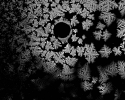
















 | |
Feb 19, 2001
The Fourier transform is linear and associative under addition, but is not
associative under multiplication. Thus, Fourier methods are suitable for
removing noise from images only when the noise can be modeled as as additive
term to the original image.
However, if defects of the image, e.g., uneven lighting, have to be
modeled as multiplicative rather than additive, direct application of Fourier
methods is inappropriate.
In terms of the illuminance and reflectance of an object, an image of the
object might be modeled as f(x,y) = i(x,y)·r(x,y). In this case, some way of
converting multiplication into addition must be employed before trying to apply
Fourier filtering. The obvious way to do this is to take logarithms of both
sides:
q(x,y) = ln[r(x,y)·i(x,y) + 1] = ln[i(x,y)] + ln[r(x,y)]
where 1 has been added to the image values to avoid problems with
ln[0].
Taking the FFT of both sides
Q(n,m) = I'(n,m) + R'(n,m)
where n and m are spatial frequencies in the x and y
directions
Now apply a suitable Fourier filter function H(n,m)
S(n,m) = QH = I'H + R'H
where I'(n,m) is the Fourier transform of ln[i(x,y)].
Now take inverse FFT
s(x,y) = ln[r(x,y)] + ln[i(x,y)]
Finally, take the exponential of both sides, and subtract the extra 1 from
each pixel:
g(x,y) = exp[s(x,y)] - 1 = r(x,y)

Examples of poor illumination:
 | Betsy shipwreck |
 | Ice crystals |



Generation of Spatial Masks
In the frequency domain,
G(u,v) = H(u,v)F(u,v)
produces the Fourier transform of a filtered image, where H
represents the frequency filter. How
can the spatial mask h(x,y) equivalent to H(u,v) be obtained?

for u,v = 0, 1, 2, …, N-1.
But for an n×n convolution
mask
 with n < N,
with n < N,
 must be zero for x > n and y > n.
must be zero for x > n and y > n.

for u,v = 0, 1, 2, …, N-1.
How can minimization, in the least-squares sense, be
achieved for the error

In matrix form,

where
 is a column vector of order N2 containing the elements of
is a column vector of order N2 containing the elements of
 ,
,
 is a column vector of order n2
containing the elements of
is a column vector of order n2
containing the elements of
 , and C is an N2 × n2 matrix of exponential terms.
A simple way to order the terms is to let
, and C is an N2 × n2 matrix of exponential terms.
A simple way to order the terms is to let
 , where i = uN + v in row order. Similarly,
, where i = uN + v in row order. Similarly,
 , for k = xn + y. Finally, C =
C(i,k) is generated from
, for k = xn + y. Finally, C =
C(i,k) is generated from

for i = uN + v, and k = xn + y, all in row order.
Putting all this in matrix notation

Setting the partial derivative equal to zero yields the
minimum of e2.
Then

giving as a final answer:

which gives the coefficients to construct an n×n
convolution mask
 from a specified N×N frequency filter H(u,v).
In general, the elements of
from a specified N×N frequency filter H(u,v).
In general, the elements of
 would be complex, but if the frequency domain filter is real and symmetric,
would be complex, but if the frequency domain filter is real and symmetric,
 is also real and symmetric.
is also real and symmetric.
Last modified on February 21, 2001
|
